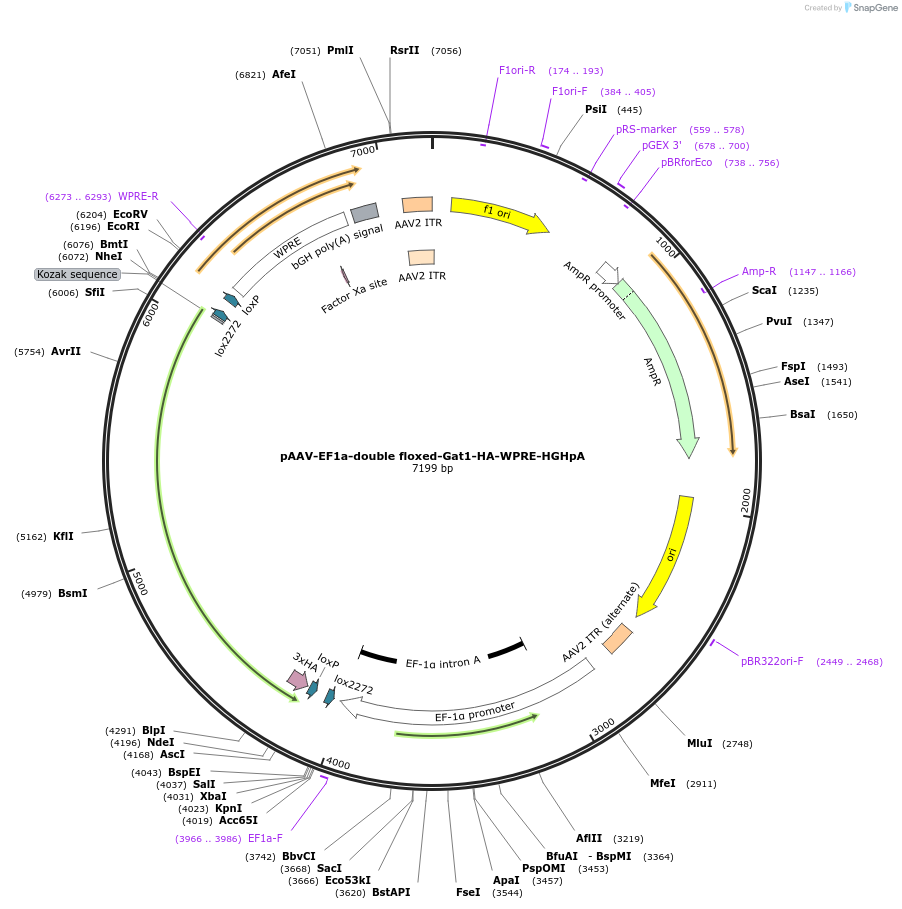pAAV-EF1a-double floxed-Gat1-HA-WPRE-HGHpA
(Plasmid
#184635)
-
PurposeExpresses the GABA membrane transporter Gat1 fused to HA, driven by the Ef1a promoter, in a Cre-dependent fashion
-
Depositing Lab
-
Sequence Information
Ordering
| Item | Catalog # | Description | Quantity | Price (USD) | |
|---|---|---|---|---|---|
| Plasmid | 184635 | Standard format: Plasmid sent in bacteria as agar stab | 1 | $85 | |
Backbone
-
Vector backbonepAAV-EF1a-double floxed-hChR2(H134R)-mCherry-WPRE-HGHpA
-
Backbone manufacturerAddgene #20297
-
Modifications to backbone3 copies of the influenza hemagglutinin (HA) coding sequence are inserted at the C-terminus
-
Vector typeAAV
Growth in Bacteria
-
Bacterial Resistance(s)Ampicillin, 100 μg/mL
-
Growth Temperature37°C
-
Growth Strain(s)NEB Stable
-
Copy numberHigh Copy
Gene/Insert
-
Gene/Insert nameGat1
-
SpeciesM. musculus (mouse)
-
GenBank IDNM_178703.4
-
Entrez GeneSlc6a1 (a.k.a. A730043E01, GABATHG, GABATR, GAT-1, Gabt, Gabt1, Gat1, XT-1, Xtrp1)
- Promoter EF1a
Cloning Information
- Cloning method Restriction Enzyme
- 5′ cloning site AscI (not destroyed)
- 3′ cloning site NheI (not destroyed)
- 5′ sequencing primer Unknown (Common Sequencing Primers)
Terms and Licenses
-
Academic/Nonprofit Terms
-
Industry Terms
- Not Available to Industry
Trademarks:
- Zeocin® is an InvivoGen trademark.
Depositor Comments
Please visit https://www.biorxiv.org/content/10.1101/2021.11.26.470142v1 for bioRxiv preprint.
These plasmids were created by your colleagues. Please acknowledge the Principal Investigator, cite the article in which the plasmids were described, and include Addgene in the Materials and Methods of your future publications.
-
For your Materials & Methods section:
pAAV-EF1a-double floxed-Gat1-HA-WPRE-HGHpA was a gift from Nicolas Tritsch (Addgene plasmid # 184635 ; http://n2t.net/addgene:184635 ; RRID:Addgene_184635) -
For your References section:
Inhibitory co-transmission from midbrain dopamine neurons relies on presynaptic GABA uptake. Melani R, Tritsch NX. Cell Rep. 2022 Apr 19;39(3):110716. doi: 10.1016/j.celrep.2022.110716. 10.1016/j.celrep.2022.110716 PubMed 35443174

